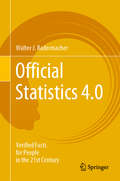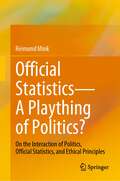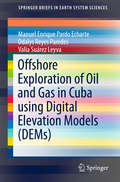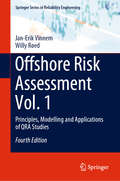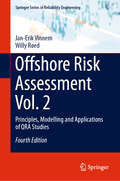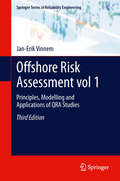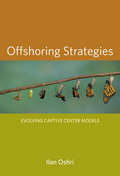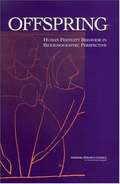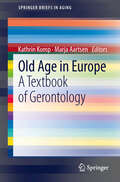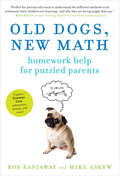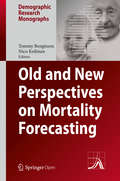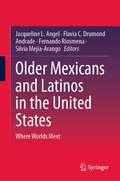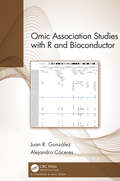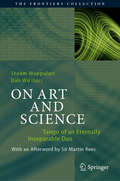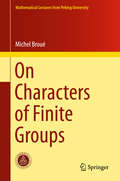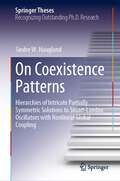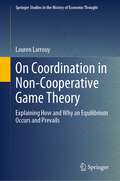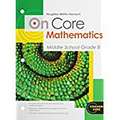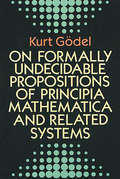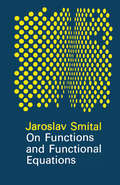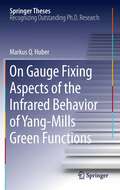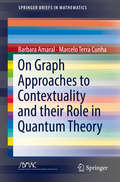- Table View
- List View
Official Statistics 4.0: Verified Facts for People in the 21st Century
by Walter J. RadermacherThis book explores official statistics and their social function in modern societies. Digitisation and globalisation are creating completely new opportunities and risks, a context in which facts (can) play an enormously important part if they are produced with a quality that makes them credible and purpose-specific. In order for this to actually happen, official statistics must continue to actively pursue the modernisation of their working methods.This book is not about the technical and methodological challenges associated with digitisation and globalisation; rather, it focuses on statistical sociology, which scientifically deals with the peculiarities and pitfalls of governing-by-numbers, and assigns statistics a suitable position in the future informational ecosystem. Further, the book provides a comprehensive overview of modern issues in official statistics, embodied in a historical and conceptual framework that endows it with different and innovative perspectives. Central to this work is the quality of statistical information provided by official statistics. The implementation of the UN Sustainable Development Goals in the form of indicators is another driving force in the search for answers, and is addressed here.This book will be of interest to a broad readership. The topics of sociology, epistemology, statistical history and the management of production processes, which are important for official statistics and their role in social decision-making processes, are generally not dealt with in statistics books. The book is primary intended for official statisticians, but researchers and advanced students in statistics, economics, sociology and the political sciences will find the book equally stimulating. Last but not least, it offers a valuable source of reflection for policymakers and stakeholders.
Official Statistics—A Plaything of Politics?: On the Interaction of Politics, Official Statistics, and Ethical Principles
by Reimund MinkThis book describes official statistics as a tool to hold up a mirror to society – but also as an instrument for those who can manipulate this mirror. It addresses the precarious interaction of politics, official statistics, and ethical principles. Three sets of themes can be derived from this relationship, which are the focus of this book: Political systems and guiding principles, official statistics as a science of the state, and ethical issues arising from them. Ultimately, the determining factor is the political system that exists in each case.The book contains eleven chapters. The first three focus on the key concepts of the book: power and morality, official statistics and policy making, and ethical principles for statistical work. Three further chapters focus on episodes that illustrate, as "drastic" examples, the misuse of official statistics over the past hundred years, covering the situation in the Soviet Union, the Third Reich and Greece. The remaining five chapters take up current topics that pose particular challenges to official statistics. These are the phenomena paraphrased by digitalisation, globalisation, happiness research, overpopulation, migration, the Covid-19 pandemic and climate change.The book is primarily aimed at statisticians working in national and international statistical institutions, but also at readers interested in statistics, national accounts, economic and statistics history, and ethical issues.
Offshore Exploration of Oil and Gas in Cuba using Digital Elevation Models (SpringerBriefs in Earth System Sciences)
by Manuel Enrique Pardo Echarte Odalys Reyes Paredes Valia Suárez LeyvaThis book provides an overview of the major changes induced by hydrocarbons (HCs) affecting rocks and surface sediments and their implications for non-seismic exploration methods, particularly for marine territories near Cuba. It examines the use of a digital elevation model (DEM) at 90x90m resolution for the detection of subtle, positive geomorphic anomalies related to hydrocarbon microseepage (vertical migration) on possible oil and gas targets. The results support the conclusion that the DEM data provides a low cost and fast offshore oil and gas preliminary exploration strategy. This data is useful serving to focus prospective areas with supplementary unconventional methods such as magnetic-induced polarization (MIP), useful to propose more expensive volumes for detailed 2D–3D seismic surveys.
Offshore Risk Assessment Vol. 1: Principles, Modelling and Applications of QRA Studies (Springer Series in Reliability Engineering)
by Jan-Erik Vinnem Willy RøedThis is the first textbook to address quantified risk assessment (QRA) as specifically applied to offshore installations and operations. As the first part of the two-volume updated and expanded fourth edition, it adds a new focus on the EU Offshore Safety Directive, and discusses the new perspective on risk from the Norwegian Petroleum Safety Authority, followed by new and updated international standards. New safety statistics for the Norwegian sectors are presented, as well as new case studies on international offshore accidents, such as the explosion on FPSO Sao Mateus in 2015, which involved 9 fatalities. Separate chapters analyse the main hazards for offshore structures: fire, explosion, collision, and falling objects, as well as structural and marine hazards. Risk mitigation and control are discussed, as well as how the results of quantitative risk assessment studies should be presented. The fourth edition presents updated hydrocarbon release statistics, together with new methods for modelling the risk from ignited hydrocarbon releases. There have been recent advances in the modelling of collision risk from passing and attending vessels, based on extensive research; these advances are described in detail, in addition to new developments in the safety of Dynamic Positioning vessels. In closing, the book provides updated statistics and lessons learned from accidents involving offshore helicopter transportation of personnel. The book offers a comprehensive reference guide for academics and students of marine/offshore risk assessment and management. It will also be of interest to professionals in the industry, as well as contractors, suppliers, consultants and regulatory authorities.
Offshore Risk Assessment Vol. 2: Principles, Modelling and Applications of QRA Studies (Springer Series in Reliability Engineering)
by Jan-Erik Vinnem Willy RøedThis is the first textbook to address quantified risk assessment (QRA) as specifically applied to offshore installations and operations. As the second part of the two-volume updated and expanded fourth edition, it adds a new focus on the recent development of Normally Unattended Installations (NUIs), which are essentially autonomous installations that combine digitalization, big data, drones and machine learning, and can be supported by W2W (walk-to-work) vessels. These minimalistic installations with no helideck and very limited safety systems will require a new approach to risk assessment and emergency planning, especially during manned periods involving W2W vessels. Separate chapters analyse the main hazards for offshore structures: fire, explosion, collision, and falling objects, as well as structural and marine hazards. The book explores possible simplifications of risk assessment for traditional manned installations. Risk mitigation and control are also discussed, as well as how the results of quantitative risk assessment studies should be presented. In closing, the book provides an updated approach to environmental risk assessment. The book offers a comprehensive reference guide for academics and students of marine/offshore risk assessment and management. It will also be of interest to professionals in the industry, as well as contractors, suppliers, consultants and regulatory authorities.
Offshore Risk Assessment vol 1.: Principles, Modelling and Applications of QRA Studies
by Jan-Erik VinnemOffshore Risk Assessment was the first book to deal with quantified risk assessment (QRA) as applied specifically to offshore installations and operations. Risk assessment techniques have been used for more than three decades in the offshore oil and gas industry, and their use is set to expand increasingly as the industry moves into new areas and faces new challenges in older regions. This updated and expanded third edition has been informed by a major R&D program on offshore risk assessment in Norway and summarizes research from 2006 to the present day. Rooted with a thorough discussion of risk metrics and risk analysis methodology, subsequent chapters are devoted to analytical approaches to escalation, escape, evacuation and rescue analysis of safety and emergency systems. Separate chapters analyze the main hazards of offshore structures: fire, explosion, collision, and falling objects as well as structural and marine hazards. Risk mitigation and control are discussed, as well as an illustration of how the results from quantitative risk assessment studies should be presented. The third second edition has a stronger focus on the use of risk assessment techniques in the operation of offshore installations. Also decommissioning of installations is covered. Not only does Offshore Risk Assessment describe the state of the art of QRA, it also identifies weaknesses and areas that need further development. This new edition also illustrates applications or quantitative risk analysis methodology to offshore petroleum applications. A comprehensive reference for academics and students of marine/offshore risk assessment and management, the book should also be owned by professionals in the industry, contractors, suppliers, consultants and regulatory authorities.
Offshoring Strategies: Evolving Captive Center Models
by Ilan OshriThe evolution of a rapidly growing mode of offshoring, captive centers: basic models, strategies, and case studies of Fortune Global 250 firms.In today's globalized economy, firms often consider offshoring when confronted by rising costs and fierce competition. One mode of offshoring has continued to grow despite the current global economic turmoil: the captive center. Captive centers are offshore subsidiaries or branch offices that provide the parent company with services, usually in the form of back-office activities. In Offshoring Strategies, Ilan Oshri examines the evolution of the captive center. He identifies basic captive center models, examines the captive center strategies pursued by Fortune Global 250 firms, describes current captive center trends, and offers detailed individual case studies that illustrate each model. His analysis highlights the strategic paths available to firms that want to maximize the returns offered by captive centers. Oshri outlines six models for captive centers that range from the basic wholly owned branch office to hybrids and joint ventures and identifies evolutionary paths along which the basic model develops. He analyzes firms' strategies during initial set-up, then tracks the changes as strategies evolve to meet different business needs. The case studies, all based on the Fortune Global 250, include the development of a basic captive unit into a complex hybrid structure; the evolution a captive center into a shared service center offering services to other international firms; the divestment of a captive center to a private equity firm; and the migration of a captive center to a location where costs were lower.
Offspring: Human Fertility Behavior in Biodemographic Perspective
by Rodolfo A. Bulatao Kenneth W. WachterDespite recent advances in our understanding of the genetic basis of human behavior, little of this work has penetrated into formal demography. Very few demographers worry about how biological processes might affect voluntary behavior choices that have demographic consequences even though behavioral geneticists have documented genetics effects on variables such as parenting and divorce. Offspring: Human Fertility Behavior in Demographic Perspective brings together leading researchers from a wide variety of disciplines to review the state of research in this emerging field and to identify promising research directions for the future.
Oklahoma Math Connects: Concepts, Skills, and Problem Solving, Course 3
by Glencoe McGraw-HillStudents can master Oklahoma's Priority Academic Student Skills in 3 Easy Steps: 1. Practice the Standards throughout the Lessons, 2. Practice the Standards throughout the Chapter, and 3. Practice the Standards before the Test.
Old Age In Europe: A Textbook of Gerontology
by Marja Aartsen Kathrin KompEurope currently is the oldest continent in the world and its population is still ageing. This demographic shift affects society, economy, and welfare states. Scholars from various disciplines and the public noted this development and wonder what effects it may have, but lack adequate information. They call for explanations that are concise and easily accessible. The book at hand fills this lacuna. It introduces readers to the most important developments, theories, concepts, and discussions in ageing studies - always keeping an eye on the current situation in Europe. Each chapter adopts the perspective of a different discipline, e.g. public health, sociology, economics, or technology. To make the explanations easy to understand, the book includes learning tools such as learning objectives, multiple choice questions, and a glossary.
Old Dogs, New Math: Homework Help For Puzzled Parents
by Mike Askew Rob Eastaway“Perfect for parents who want to understand the different methods to do arithmetic their children are learning—and why they are being taught that way.” —Keith Devlin, award-winning Stanford University mathematician “Can you help me with my math homework?” If this question fills you with fear (or even panic), then Old Dogs, New Math is here to help! Gone are the days when elementary school students simply memorized their times tables and struggled through long division. Today, students are expected not just to find the right answer, but also to use the best method—and to explain why it works. If your attempts to help your child are met with “That’s not how the teacher does it,” then it’s time to take the stress out of math homework. Old Dogs, New Math demystifies Common Core math for parents, including: Number lines, place value and negative numbers Long multiplication and division Fractions, percentages and decimals Shapes, symmetry and angles Data analysis, probability and chance Complete with sample questions, examples of children’s errors, and over 25 games and activities, Old Dogs, New Math will not only help you and your child subtract on a number line or multiply on a grid—but also help you discover math all around you, and have fun doing it!
Old and New Perspectives on Mortality Forecasting (Demographic Research Monographs)
by Tommy Bengtsson Nico KeilmanThis open access book describes methods of mortality forecasting and discusses possible improvements. It contains a selection of previously unpublished and published papers, which together provide a state-of-the-art overview of statistical approaches as well as behavioural and biological perspectives. The different parts of the book provide discussions of current practice, probabilistic forecasting, the linearity in the increase of life expectancy, causes of death, and the role of cohort factors. The key question in the book is whether it is possible to project future mortality accurately, and if so, what is the best approach. This makes the book a valuable read to demographers, pension planners, actuaries, and all those interested and/or working in modelling and forecasting mortality.
Older Mexicans and Latinos in the United States: Where Worlds Meet
by Jacqueline L. Angel Fernando Riosmena Flavia C. Drumond Andrade Silvia Mejia-ArangoThis book delves into the consequences of rapid population aging for Mexico and U.S. Latinos, impacting various institutions, including families, the labor force, and healthcare systems. It examines in depth the causes and consequences of the increasing prevalence of cognitive impairment and dementia, especially early-onset decline in the Mexican-origin population. The book identifies resilience factors as critical to successful aging and health in the Mexican and Mexican-American populations from a transdisciplinary perspective. It also examines the diversity in the experiences of older adults with dementia and related disorders and that of their families in Mexico and the United States. The book also helps to better understand the levels of need and support capacity in both nations and the organizational contexts of long-term care in both countries. The ultimate goal of this sixth volume in the series on aging in the Americas is to identify critical sources of vulnerability and possible policy options for closing the gap in affordable and sustainable long-term care and financial wellbeing for low-resource populations living with dementia and other medical conditions in both countries. The volume presents new information, consensus data, potential venues for intervention, and action frameworks to advance current knowledge grounded in global aging health systems research of closing disparities in vulnerable populations at high risk of declining cognitive and physical health in two different political contexts. As such, the book provides a wealth of information for researchers, policy makers and professionals in the field of population aging.
Omic Association Studies with R and Bioconductor
by Juan R. González Alejandro CáceresAfter the great expansion of genome-wide association studies, their scientific methodology and, notably, their data analysis has matured in recent years, and they are a keystone in large epidemiological studies. Newcomers to the field are confronted with a wealth of data, resources and methods. This book presents current methods to perform informative analyses using real and illustrative data with established bioinformatics tools and guides the reader through the use of publicly available data. Includes clear, readable programming codes for readers to reproduce and adapt to their own data. Emphasises extracting biologically meaningful associations between traits of interest and genomic, transcriptomic and epigenomic data Uses up-to-date methods to exploit omic data Presents methods through specific examples and computing sessions Supplemented by a website, including code, datasets, and solutions
On Art and Science: Tango of an Eternally Inseparable Duo (The Frontiers Collection)
by Shyam Wuppuluri Dali WuEinstein once remarked "After a certain high level of technical skill is achieved, science and art tend to coalesce in aesthetics, plasticity, and form. The greatest scientists are always artists as well". In this volume, some of the world’s leading thinkers come together to expound on the interrelations between sciences and arts. While one can segregate art and place it outside the scientific realm, it is, nevertheless, inextricably linked to our essential cognitive/emotional/perceptual modalities and abilities, and therefore lies alongside and in close contact with the method of science and philosophy. What inspiration can scientists draw from art and how can scientific spirit foster our understanding and creation of aesthetic works? How are art and science grounded in our cognition? What role does perception play in science and art? Are criteria for beauty in art and science the same? How does evolution shape our understanding of art? How do science, art and scientifico-artistic frameworks shape society as a whole and help us address its pressing issues? The epistemological and ontological aspects haunt artists, philosophers and scientists alike. The essays in this volume address these manifold questions while also elucidating the pragmatic role they play in our daily life.
On Characters of Finite Groups (Mathematical Lectures from Peking University)
by Michel BrouéThis book explores the classical and beautiful character theory of finite groups. It does it by using some rudiments of the language of categories. Originally emerging from two courses offered at Peking University (PKU), primarily for third-year students, it is now better suited for graduate courses, and provides broader coverage than books that focus almost exclusively on groups.The book presents the basic tools, notions and theorems of character theory (including a new treatment of the control of fusion and isometries), and introduces readers to the categorical language at several levels. It includes and proves the major results on characteristic zero representations without any assumptions about the base field. The book includes a dedicated chapter on graded representations and applications of polynomial invariants of finite groups, and its closing chapter addresses the more recent notion of the Drinfeld double of a finite group and the corresponding representation of GL_2(Z).
On Coexistence Patterns: Hierarchies of Intricate Partially Symmetric Solutions to Stuart-Landau Oscillators with Nonlinear Global Coupling (Springer Theses)
by Sindre W. HauglandThis book is about coexistence patterns in ensembles of globally coupled nonlinear oscillators. Coexistence patterns in this respect are states of a dynamical system in which the dynamics in some parts of the system differ significantly from those in other parts, even though there is no underlying structural difference between the different parts. In other words, these asymmetric patterns emerge in a self-organized manner. As our main model, we use ensembles of various numbers of Stuart-Landau oscillators, all with the same natural frequency and all coupled equally strongly to each other. Employing computer simulations, bifurcation analysis and symmetry considerations, we uncover the mechanism behind a wide range of complex patterns found in these ensembles. Our starting point is the creation of so-called chimeras, which are subsequently treated within a new and broader context of related states.
On Coordination in Non-Cooperative Game Theory: Explaining How and Why an Equilibrium Occurs and Prevails (Springer Studies in the History of Economic Thought)
by Lauren LarrouyBy offering a critical assessment of the evolution of standard game theory, this book argues for a shift in the ontology and methodology of game theory for appraising games, one based on understanding the players’ strategic reasoning process. Analyzing the history of economic thought, the book highlights the methodological issues faced by standard game theory in its treatment of strategic reasoning and the consequence it has on the status of players’ beliefs. It also highlights how the two original contributions of T. C. Schelling and M. Bacharach can be applied to these issues. Furthermore, the book assesses the intersubjective dimension in games by applying the cognitive sciences and by integrating simulation theory into game theory. Consequently, this book offers an interdisciplinary approach for reassessing the nature of the intersubjectivity involved in strategic reasoning. It shows that the analysis of games should involve the study and identification of the reasoning process that leads the players to a specific outcome, i.e., to a specific solution. A game should not be understood (as is done in standard game theory) as a mathematical representation of an individual choice at equilibrium. This requires investigating the players’ capacity for coordination. Understanding the process of coordination allows us to understand strategic reasoning and ultimately to provide new answers to the indeterminacy problem, one of the central hurdles in game theory, and one that underscores its normative difficulties.
On Exciton–Vibration and Exciton–Photon Interactions in Organic Semiconductors (Springer Theses)
by Antonios M. AlvertisWhat are the physical mechanisms that underlie the efficient generation and transfer of energy at the nanoscale? Nature seems to know the answer to this question, having optimised the process of photosynthesis in plants over millions of years of evolution. It is conceivable that humans could mimic this process using synthetic materials, and organic semiconductors have attracted a lot of attention in this respect. Once an organic semiconductor absorbs light, bound pairs of electrons with positively charged holes, termed `excitons’, are formed. Excitons behave as fundamental energy carriers, hence understanding the physics behind their efficient generation and transfer is critical to realising the potential of organic semiconductors for light-harvesting and other applications, such as LEDs and transistors. However, this problem is extremely challenging since excitons can interact very strongly with photons. Moreover, simultaneously with the exciton motion, organic molecules can vibrate in hundreds of possible ways, having a very strong effect on energy transfer. The description of these complex phenomena is often beyond the reach of standard quantum mechanical methods which rely on the assumption of weak interactions between excitons, photons and vibrations. In this thesis, Antonios Alvertis addresses this problem through the development and application of a variety of different theoretical methods to the description of these strong interactions, providing pedagogical explanations of the underlying physics. A comprehensive introduction to organic semiconductors is followed by a review of the background theory that is employed to approach the relevant research questions, and the theoretical results are presented in close connection with experiment, yielding valuable insights for experimentalists and theoreticians alike.
On Formally Undecidable Propositions of Principia Mathematica and Related Systems (Dover Books on Mathematics)
by Kurt GödelIn 1931, a young Austrian mathematician published an epoch-making paper containing one of the most revolutionary ideas in logic since Aristotle. Kurt Giidel maintained, and offered detailed proof, that in any arithmetic system, even in elementary parts of arithmetic, there are propositions which cannot be proved or disproved within the system. It is thus uncertain that the basic axioms of arithmetic will not give rise to contradictions. The repercussions of this discovery are still being felt and debated in 20th-century mathematics.The present volume reprints the first English translation of Giidel's far-reaching work. Not only does it make the argument more intelligible, but the introduction contributed by Professor R. B. Braithwaite (Cambridge University}, an excellent work of scholarship in its own right, illuminates it by paraphrasing the major part of the argument.This Dover edition thus makes widely available a superb edition of a classic work of original thought, one that will be of profound interest to mathematicians, logicians and anyone interested in the history of attempts to establish axioms that would provide a rigorous basis for all mathematics. Translated by B. Meltzer, University of Edinburgh. Preface. Introduction by R. B. Braithwaite.
On Functions and Functional Equations
by J. SmitalOn Functions and Functional Equations introduces the main topics in iteration theory and the theory of functional equations with emphasis on applications in the fields of mathematics, physics, biology, chemistry, and electronics and mechanical engineering. The book contains many classical results as well as important, more recent results. It also includes numerous exercise and some problems that have yet to be resolved. The book is accessible to readers having a secondary level mathematical education.
On Gauge Fixing Aspects of the Infrared Behavior of Yang-Mills Green Functions
by Markus Q. HuberQuarks are the main constituents of protons and neutrons and hence are important building blocks of all the matter that surrounds us. However, quarks have the intriguing property that they never appear as isolated single particles but only in bound states. This phenomenon is called confinement and has been a central research topic of elementary particle physics for the last few decades. In order to find the mechanism that forbids the existence of free quarks many approaches and ideas are being followed, but by now it has become clear that they are not mutually exclusive but illuminate the problem from different perspectives. Two such confinement scenarios are investigated in this thesis: Firstly, the importance of Abelian field components for the low-energy regime is corroborated, thus supporting the dual superconductor picture of confinement and secondly, the influence of the Gribov horizon on non-perturbative solutions is studied.
On Graph Approaches to Contextuality and their Role in Quantum Theory (SpringerBriefs in Mathematics)
by Barbara Amaral Marcelo Terra CunhaThis book explores two of the most striking features of quantum theory – contextuality and nonlocality – using a formulation based on graph theory. Quantum theory provides a set of rules to predict probabilities of different outcomes in different experimental settings, and both contextuality and nonlocality play a fundamental role in interpreting the outcomes. In this work, the authors highlight how the graph approach can lead to a better understanding of this theory and its applications. After presenting basic definitions and explaining the non-contextuality hypothesis, the book describes contextuality scenarios using compatibility hypergraphs. It then introduces the exclusivity graph approach, which relates a number of important graph-theoretical concepts to contextuality. It also presents open problems such as the so-called Exclusivity Principle, as well as a selection of important topics, like sheaf-theoretical approach, hypergraph approach, and alternative proofs of contextuality.
